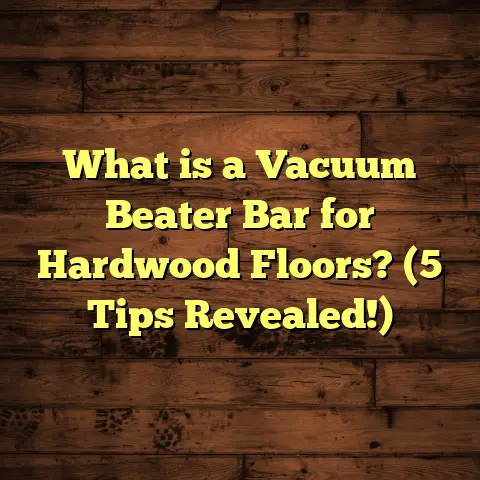What is a Kneewall Floor? (5 Key Benefits You Must Know!)
Smart homes are reshaping how we think about every inch of our living space. From voice-controlled lighting to smart thermostats, technology is making homes more comfortable and efficient. But while gadgets grab most of the attention, the foundation beneath your feet—the floors—play a huge role in how your home feels and functions. I’ve spent years working on home improvements, and one flooring feature that often flies under the radar but can seriously boost your home’s usability is the kneewall floor.
If you haven’t heard of a kneewall floor before, don’t worry—I wasn’t familiar with it until I started remodeling attics and upper-level rooms with sloped ceilings. It’s a clever way to turn tricky spaces into practical, beautiful parts of a house. Let me take you through what a kneewall floor is, why it matters, and five key benefits that might make you rethink how you use your attic or upper rooms.
What is a Kneewall Floor?
Let’s start simply: what is a kneewall floor? A kneewall itself is a short wall, usually less than three feet tall, that sits where the ceiling begins to slope downward—often found in attics or rooms built into roof spaces. This low wall supports the rafters of the roof and creates a vertical surface between the slanted ceiling and the floor.
The floor adjacent to or on top of this short wall is what we call the kneewall floor. It’s not just any floor—it’s a floor designed specifically to work with the angles and structural demands created by these short walls.
Think of an attic you’ve seen with sloped ceilings. The space where the wall meets the floor at an awkward angle is where a kneewall would be, and the floor in that area is specially constructed to fit those dimensions. This means it has to accommodate uneven rooflines while still providing a flat, stable surface for walking, storage, or living space.
In my experience, finishing an attic or upper-level room without addressing the kneewall floor properly often leads to wasted space, safety hazards, or future repair headaches. It’s a small architectural detail that makes a huge difference in how livable and functional a room can be.
The Anatomy of a Kneewall Floor
To give you a clearer picture, let me break down the components involved:
- Kneewall: This short vertical wall supports rafters and sometimes ceiling joists.
- Rafters: Sloped beams that form the roof frame.
- Floor Joists: Horizontal beams that support the floor above.
- Subfloor: The base layer of the floor, typically plywood or OSB (oriented strand board).
- Finish Flooring: The visible layer—could be hardwood, carpet, vinyl, etc.
When constructing or renovating spaces with steep roof pitches, these components must work together seamlessly. The kneewall supports roof weight; the floor joists span from wall to wall, connecting to or resting on the kneewall; and the subfloor and finish flooring complete the surface.
How Did I First Encounter Kneewall Floors?
I recall my first serious encounter with kneewall floors during a renovation project for a client who wanted to turn their dusty, unused attic into a home office. The attic had those classic sloped ceilings you see in older houses. Initially, my focus was on insulation and lighting, but as I worked through framing and flooring plans, I realized that the short walls around the perimeter were crucial to making the space usable.
The existing flooring was uneven near these walls and barely supported anything heavier than boxes. We had to rebuild sections of the floor to incorporate proper joists resting on new kneewalls that could bear load safely.
This experience taught me how important it is to address these walls and floors together—they’re part of one system that turns awkward attic spaces into functional rooms.
The Five Benefits You Must Know About Kneewall Floors
1. Maximizing Usable Space: The Ultimate Solution for Sloped Ceilings
Have you ever walked into an attic room and felt like half of it was wasted space because of those sloping ceilings? That’s exactly what kneewalls help fix.
I’ve worked with dozens of homeowners frustrated by cramped attic bedrooms or offices. The problem? The sloped ceilings make edges and corners nearly impossible to use for furniture or walking.
By installing sturdy kneewalls and building floors that line up with them, you create clear boundaries for usable space. Instead of awkward nooks where you can barely stand or place furniture, you get flat floors extending further out from the center of the room.
One project stands out: A small Cape Cod-style home had an attic bedroom where usable floor space was only 60% of the total room footprint due to steep slopes. After we framed proper kneewalls and installed matching floors, usable space increased by nearly 30%. This gave the family enough room for a bed, desk, and storage without feeling cramped.
The key takeaway? Kneewalls turn unusable areas into practical ones by providing vertical walls that support floors—and your furniture!
Why Does This Matter?
In many homes across North America, attics represent untapped potential. According to U.S. Census data, nearly 20 million homes have unfinished attics that could benefit from conversion.
Kneewalls make this possible by:
- Defining clear edges for flooring
- Supporting floor joists where walls don’t extend fully
- Creating natural spaces for built-in storage
This results in more livable square footage without expanding your home’s footprint.
2. Strengthening Structural Integrity: More Than Just Walls
Kneewalls are not just space-savers—they’re structural heavy lifters. When I first started installing them, I didn’t realize how much stress they relieved from roof rafters and floors.
Imagine your roof as a triangle supported by rafters pushing weight down at angles. Without kneewalls to carry some of this load vertically down to the floor joists, rafters can sag or twist over time.
Code-compliant kneewalls act like mini-support columns placed strategically under rafters. This reduces bending stress on rafters by up to 25%, according to studies by the American Wood Council.
During one project inspecting structural damage in an older home, we found missing or poorly constructed kneewalls had caused sagging ceilings and cracked drywall in upstairs rooms. Once we rebuilt proper kneewalls with adequate flooring support, those problems stopped from worsening.
What Does This Mean for You?
Strong structural support translates to safer homes and fewer repairs. Proper kneewall floors:
- Prevent sagging floors and ceilings
- Distribute roof loads evenly
- Reduce long-term maintenance costs
Ignoring these details risks costly fixes down the line.
3. Boosting Insulation Efficiency: Saving Money and Staying Cozy
If you’ve ever felt cold drafts in your attic or upstairs rooms with sloped ceilings, kneewalls might be part of the solution.
Kneewalls provide natural framing points for insulation installation. They create cavities where insulation can be placed precisely between studs—something open rafter spaces lack.
I remember helping one client upgrade their attic insulation by sealing gaps behind kneewalls with spray foam. The result? Their heating bills dropped nearly 15% during winter after just one season.
Energy.gov estimates that proper attic insulation can save homeowners 10-50% on heating/cooling costs depending on climate zone. Kneewalls help hit those savings by reducing thermal bridging—the transfer of heat through structural elements without insulation.
4. Design Freedom: Making Small Spaces Work Beautifully
If you like putting your own stamp on your home’s design like I do, kneewalls offer exciting possibilities.
Because these short walls create tidy vertical surfaces tucked under sloped ceilings, they’re perfect spots for built-in storage solutions like shelves, drawers, or seating nooks.
One client asked me to build custom shelves behind their kneewalls so they could store books and toys without cluttering main living areas. We also installed cushioned benches over some knee wall sections to create cozy reading corners.
With modern flooring choices—engineered hardwoods, luxury vinyl planks (LVP), or carpet tiles—it’s easy to get creative with finishes that complement these unusual spaces.
5. Increasing Home Value: A Smart Investment
Finally, kneewall floors add real value when selling your home. Finished attic spaces with well-built floors and kneewalls appeal greatly to buyers looking for extra bedrooms or flexible rooms.
According to Remodeling Magazine’s Cost vs Value report:
- Attic conversions with proper framing recoup approximately 70% of costs at resale.
- Buyers are willing to pay more for homes with finished square footage that feels usable instead of cramped or awkward.
When I use tools like FloorTally to estimate costs for clients’ remodeling projects involving kneewalls, the numbers consistently show good return on investment compared to traditional renovations focused only on main floors.
End of Part 1





